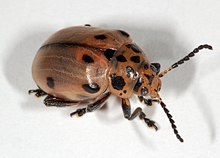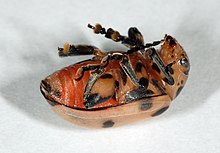Spotted poison dart beetle
| Spotted poison dart beetle | ||||||||||||
|---|---|---|---|---|---|---|---|---|---|---|---|---|

Spotted poison dart beetle larva ( Diamphidia nigroornata ) |
||||||||||||
| Systematics | ||||||||||||
|
||||||||||||
| Scientific name | ||||||||||||
| Diamphidia nigroornata | ||||||||||||
| ( Stål , 1858) |
The spotted poison arrow beetle ( Diamphidia nigroornata ) belongs to the flea beetles (subfamily Galerucinae, tribe Alticini) in the leaf beetle family (Chrysomelidae). The larvae are used by indigenous peoples of Africa to make arrow poison . Other species known as poison dart beetles are Diamphidia vittatipennis and Polyclada flexuosa , but also the larvae of the ground beetle Lebistina holubi .
features
The adults of the spotted poison arrow beetle are seven to nine millimeters in size. The basic color is yellow, the black spots are found on the head, on the pronotum and the wing covers . Their number can vary slightly. The antennae are dark with a yellow base. The scutellum is black. The legs are colored basal yellow, apical black, the anterior and middle splints are black, the rear splints are basal yellow and the tarsi black. As with other members of the subfamilies Criocerinae, Chrysomelinae, Galerucinae and Alticinae, poison glands are found on the pronotum and elytra for defense.
Occurrence
Of the three species of the genus Diamphidia , also known from southern Africa for the production of arrow poison , nigroornata is the most widespread and also the most common. The spotted poison dart beetle occasionally appears sympatric with Diamphidia femoralis and Diamphidia vitatipennis .
Nutrition and development
The larvae and adults of Diamphidia nigroornata mainly feed on Commiphora angolensis , a balsam tree , but also on C. africana and C. pyracanthoides . The adult females lay their eggs in groups of up to 15 on the branches of the Commiphora trees. The mother animal covers the eggs with greenish excrement, which after drying makes the eggs appear dark brown and camouflages them very well. The larvae go through three stages and feed on the leaves of the host plants. After this ripening process is complete , they dig themselves half a meter to a meter deep into sandy soil on the host plant and produce a sand cocoon with the help of an excretion secretion. The larvae hide there for several years before they reach the pupal stage . So far there is no precise information about the duration of the pupal stage and the trigger for the transformation.
Enemies
In addition to humans as the enemy of animals, the larvae of Diamphidia nigroornata are parasitized in their sand cocoons by the larvae of the ground beetle Lebistina holubi . This parasite is also poisonous and is used by the indigenous people as an arrow poison.
Use as an arrow poison
As early as 1864, Thomas Baines, as one of the first Europeans, describes the use of larvae for the production of arrow poisons after his trip through South West Africa in 1861/1862. However, the exact diagnosis of the species remained unclear well into the 20th century.
In general, animal poisons are used less often for hunting in Africa. In most cases, vegetable products are also added to animal products, so that only the combination is the key to success. Occasionally, the poison of the larvae is probably used unmixed by the San -Bu people.
Because of the long resting phase of the larvae in the ground, they can be found all year round and thus represent a base for the poison that is available at all times. Before the hunt, the larvae are freed from the sand cocoons and placed in a trough (for example in the socket of a thigh bone) carefully squeezed. In addition, the juice is supplemented with vegetable poisons. Since the protein poison is heat-sensitive, it is applied underneath the tip of an arrow without cooking and air-dried. About ten larvae are usually used for an arrow and the shelf life should be up to a year. The poison only works slowly via the bloodstream, so that the hunter has to follow his victim for a few hours to days.
Making the poison
The following photos show a San producing arrow poison using the innards of Diamphidia nigroornata and roasted seeds of Bobgunnia madagascariensis (= Swartzia m. ) On the border between Namibia and Botswana :
swell
literature
- Thomas Baines : Explorations in South-West Africa: being an account of a journey in the years 1861 and 1862 from Walvisch Bay, on the Western Coast to Lake Ngami and the Victoria Falls . - London: Longman, Green, Longman, Roberts, & Green, 1864
- Thomas Baines: The northern goldfields diaries of Thomas Baines (1820–1875), edited by JPR Wallis, 3 volumes. - London, Chatto & Windus, 1864
- R. Boehm: About the poison of the larvae of Diamphidia locusta . - Naunyn-Schmiedeberg's Archives of Pharmacology 38 (5-6): 424-427, 1897
- L. Deroe, JM Pasteels: Distribution of adult defense glands in chrysomelids (Coleoptera: Chrysomelidae) and its significance in the evolution of defense mechanisms within the family . - Journal of Chemical Ecology 8 (1): 67-82, 1982
- C. Koch: Preliminary notes on the coleopterological aspect of the arrow poison of the bushmen . - Pamphlet of the South African Biological Society 20: 49-54, 1958
- L. Lewin: Blepharida evanida, a new poison arrow beetle . - Naunyn-Schmiedeberg's Archives of Pharmacology 69 (1): 59-66, 1912
- O. Nadler: The arrow poison of !Kung -Buschleute . - Heidelberg: Oserna-africana-Verlag, 2004
- H.-D. Neuwinger: The Kalahari-San arrow poison: Deadly beetle larvae . - Biology in Our Time 34 (2): 88-94, 2004
- EM Shaw, PL Woolley, FA Rae: Bushman arrow poisons . - Cimbebasia 7 (2): 2-41, 1963
- F. Starcke: On the effects of the poison of the larvae of Diamphidia locusta (arrow poison of the Kalachari) . - Naunyn-Schmiedeberg's Archives of Pharmacology 38 (5-6): 428-446, 1897
- JMR Woollard, FA Fuhrman, HS Mosher: The bushman arrow toxin, diamphidia toxin: isolation from pupae of Diamphidia nigro-ornata . - Toxicon 22: 937-946, 1984
Web links
- Diamphidia nigroornata (in English)
- African Ethnobotany: Poisons and Medicines ( Memento of March 14, 2012 in the Internet Archive )
- Use of the poison: How San hunters use beetles to poison their arrows (in English)






